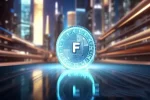TRON Chain (The Field Chain) is an efficient, decentralized platform based on blockchain technology, aiming to construct a global digital content entertainment ecosystem. It has attracted a large number of developers and users through its advantages of high throughput and low transaction costs. In this paper, we will analyze the basic concepts of TRON chain, its technical structure and its application scenarios in the cryptocurrency field, which will help readers understand the operation mode of TRON chain and its future development potential more clearly.

Basic concepts of the TRON chain
TRON (Wavefield) is a blockchain-based decentralized platform founded by Chinese entrepreneur Sun Yuchen in 2017. Its main purpose is to break the current centralized structure of the digital content industry and provide a fairer way to create and share digital entertainment content.TRON Chain is an open-source blockchain platform with the advantages of high throughput, high scalability, and low transaction fees, which is especially suitable for large-scale blockchain applications. The platform uses core technologies including smart contracts, decentralized applications (DApp) and distributed storage.
TRON's native token is TRX, which is the primary currency for user transactions and payments in the TRON ecosystem.TRX is not only used to pay for transactions, but also functions in a variety of decentralized applications in the TRON ecosystem to support the exchange of value between content creators and consumers.
Technical structure of the TRON chain
The technical architecture of the TRON chain can be divided into three layers: the protocol layer, the core layer and the application layer. Each layer carries out different functions and works in concert to ensure the efficient operation of the entire system.
Protocol Layer: This layer is responsible for ensuring the security and decentralized nature of the blockchain, which mainly includes distributed ledger technology and consensus mechanism.TRON has adopted the Delegated Proof of Stake (DPoS) consensus mechanism, which not only improves the speed of transaction confirmation, but also reduces energy consumption.
Core Layer: The core layer consists of smart contracts, virtual machines (TVMs) and data storage; TRON's smart contracts are powerful enough to allow developers to build a variety of decentralized applications (DApps) on top of them; and TRON's virtual machines (TVMs) support an ethereum-compatible smart contracting language, making it easy for ethereum developers to migrate to the TRON platform.
Application Layer: This layer is the top layer of the TRON ecosystem and focuses on the development of various decentralized applications. TRON supports a wide range of application scenarios, including digital content sharing, social media, gaming, and the financial sector, providing extensive room for development and innovation.
TRON chain consensus mechanism: DPoS
One of the core elements of TRON's efficient operation is its Proof of Stake (DPoS) mechanism, a relatively new consensus mechanism whose main feature is the election of delegates (called "super delegates") to ensure the operation of the blockchain network and transaction verification.
Superdelegates are nodes elected by TRON coin holders to generate new blocks and maintain network stability. Compared to traditional Proof-of-Work (PoW) mechanisms, DPoS can dramatically increase transaction processing speeds and significantly reduce resource consumption, and TRON's DPoS consensus mechanism is capable of processing thousands of transactions per second, which gives TRON an advantage in high-frequency transaction and large-scale application scenarios.
TRON chain application scenarios
As an open platform, the TRON chain has a wide range of application scenarios, especially in the areas of digital entertainment and content creation. The following are some of the major application scenarios of TRON:
Decentralized Application (DApp): TRON supports the development of a variety of decentralized applications, which can run on the blockchain, avoiding the intervention of traditional application middlemen. Developers can utilize the TRON platform to build various types of DApps such as music, videos, social media, and so on.
Digital Entertainment Ecosystem: One of the best features of TRON is that it aims to create a decentralized digital entertainment ecosystem. For example, TRON has begun to explore the video sharing and downloading field through its cooperation with BitTorrent, a famous P2P video platform. Users can create, share and earn TRX tokens on the platform, realizing value exchange.
Financial Applications: TRON also supports a variety of decentralized financial (DeFi) applications, such as decentralized exchanges (DEX), stablecoins, lending platforms, and more. These applications enable users to lend, trade and manage assets in a decentralized environment.
Gaming: There are also many blockchain-based games on the TRON platform. Players can use TRX to make in-game purchases, and in-game props and assets can be traded on the blockchain to safeguard asset ownership and transparency.
Strengths and Challenges of the TRON Chain
The TRON chain has a number of distinct advantages, which is one of the reasons why it is quickly attracting developers and users.TRON's transaction speed is very fast, capable of handling thousands of transactions per second, which gives it an advantage in high-frequency transactions and large-scale applications. Due to its low transaction fees, TRON is more attractive than many other blockchain platforms such as Ether, especially for small transactions and micropayment scenarios.

The TRON chain is also facing some challenges. For example, due to the nature of its DPoS consensus mechanism, some people believe that TRON is not as decentralized as platforms such as Bitcoin and Ether.TRON's development has also been affected by competition in the marketplace, especially in the DeFi and NFT space, where other platforms such as Ether and Solana are also actively competing for market share.
TRON's Future Potential
As an evolving blockchain platform, TRON's future development potential should not be underestimated. With the rapid development of areas such as Decentralized Finance (DeFi), Non-Homogenized Token (NFT) and Decentralized Apps (DApp), TRON is expected to continue to leverage its strengths in these areas.
TRON's partners include some world-renowned companies such as BitTorrent, which provides strong support for the expansion and growth of its ecosystem. In the future, TRON is expected to further expand its application landscape and attract more developers and users to participate in it, promoting the popularization and application of blockchain technology.
Conclusion
As a decentralized blockchain platform with the advantages of high performance and low cost, TRON chain has demonstrated a wide range of application potential in the fields of digital entertainment, finance, and gaming. With the continuous iteration of its technology and the expansion of its ecosystem, TRON will play an increasingly important role in the field of cryptocurrency and blockchain. Whether for investors, developers, or ordinary users, understanding the operation principles and application scenarios of the TRON chain will be helpful to the future blockchain world.














